Toyota Motor Corporation
- Summary
- Brief Company Overview
- Recent Developments
- Financial Highlights
- Business Overview
- Risks
- Company History
Summary
- Toyota Motor Corporation is a multinational automotive manufacturer established in August 1937 and headquartered in Toyota City, Aichi, Japan.
- Toyota Motor Corporation has two lines of business - automotive, and non-automotive. Under the automotive segment, the company produces vehicles, and under the other segment it produces the spare parts and accessories.
- During fiscal 2022, 23.4% of Toyota’s automobile unit sales on a consolidated basis were in Japan, 29.1% were in North America, 12.4% were in Europe and 18.7% were in Asia. The remaining 16.4% of consolidated unit sales were in other markets.
- The company has reported ¥9,754.6 billion in sales for the period of three months ended 31 December, 2022. Sales during the same period of the past year was ¥7,785.7 billion. net income attributable to Toyota Motor Corporation during Q3 of FY23 is reported ¥727.9 billion as compared to ¥791.7 billion, a decrease of ¥63.7 billion.
- Toyota had sales revenues for fiscal 2022 of ¥31,379.5 billion, an increase of ¥4,164.9 billion, or 15.3%, compared with the prior fiscal year. Net income attributable to Toyota Motor Corporation increased by ¥604.8 billion, or 26.9%, to ¥2,850.1 billion during fiscal 2022 compared with the prior fiscal year. Earnings per share (EPS) of the company for the fiscal year 2022 is ¥205.23, up from ¥160.65.
Brief Company Overview
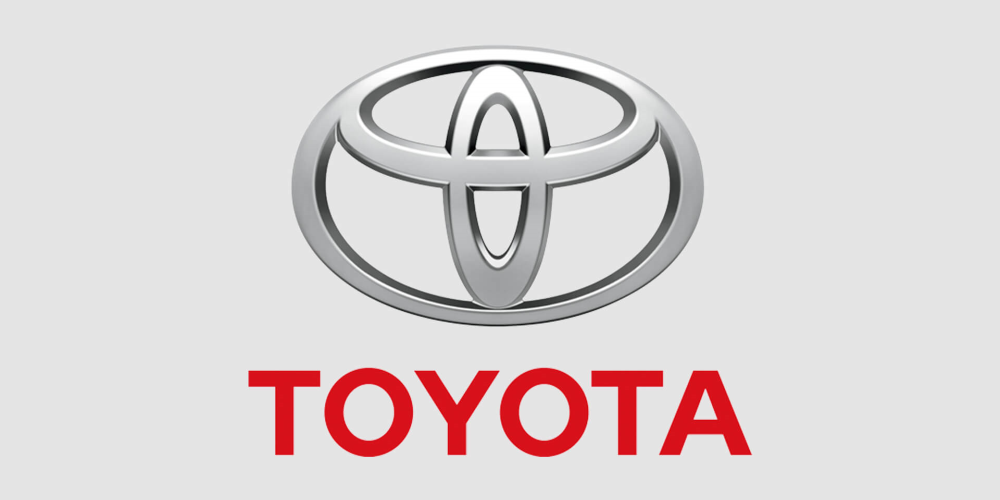 Toyota Motor Corporation (TSE/TYO:7203; NAG:7203; NYSE:TM; LSE:TYT) is a multinational automotive manufacturer established in August 1937. The company is headquartered in Toyota City, Aichi, Japan. Toyota commenced operations in 1933 as the automobile division of Toyota Industries Corporation (formerly Toyoda Automatic Loom Works, Ltd.). Toyota became a separate company in August 1937. In 1982, the Toyota Motor Company and Toyota Motor Sales merged into one company, the Toyota Motor Corporation of today. As of March 31, 2022, Toyota operated through 559 consolidated subsidiaries (including structured entities) and 169 associates and joint ventures accounted for by the equity method.
Toyota Motor Corporation (TSE/TYO:7203; NAG:7203; NYSE:TM; LSE:TYT) is a multinational automotive manufacturer established in August 1937. The company is headquartered in Toyota City, Aichi, Japan. Toyota commenced operations in 1933 as the automobile division of Toyota Industries Corporation (formerly Toyoda Automatic Loom Works, Ltd.). Toyota became a separate company in August 1937. In 1982, the Toyota Motor Company and Toyota Motor Sales merged into one company, the Toyota Motor Corporation of today. As of March 31, 2022, Toyota operated through 559 consolidated subsidiaries (including structured entities) and 169 associates and joint ventures accounted for by the equity method.
Toyota sells its vehicles in approximately 200 countries and regions. Toyota’s primary markets for its automobiles are Japan, North America, Europe and Asia. During fiscal 2022, 23.4% of Toyota’s automobile unit sales on a consolidated basis were in Japan, 29.1% were in North America, 12.4% were in Europe and 18.7% were in Asia. The remaining 16.4% of consolidated unit sales were in other markets.
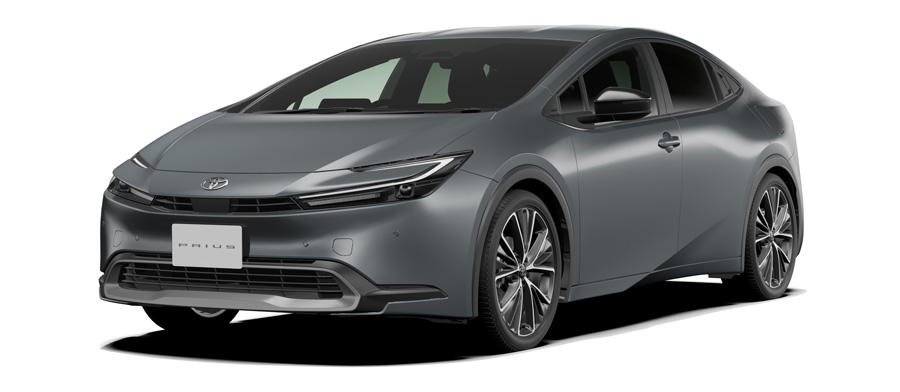
The total number of Toyota employees, on a consolidated basis, was 372,817 as of March 31, 2022, 366,283 as of March 31, 2021. Akio Toyoda is the current president of Toyota Motor Corporation. He is the great-grandson of the industrialist, Sakichi Toyoda. Toyota is listed on Tokyo Stock Exchange (as 7203), Nagoya Stock Exchange (as 7203), New York Stock Exchange (as TM), and London Stock Exchange (as TYT).
Recent Developments
Hydrogen Engine
Toyota Motor Corporation announced in April 2021 that it is working on the technological development of a hydrogen engine. While FCEVs are driven by electric motors powered using electricity generated by a chemical reaction between hydrogen and airborne oxygen, vehicles powered by hydrogen engines get their power by directly burning hydrogen as fuel in a modified conventional gasoline engine setup. The fuel is 100-percent pure hydrogen, unmixed with gasoline. As no fossil fuels are burned, except for the combustion of minute amounts of engine oil during driving, hydrogen engine vehicles emit nearly no CO2 when in operation. To realize carbon neutrality, it will be important to increase people’s options without losing sight of the goal.
Software and Connected Initiatives
This era of automobile manufacturing is termed as CASE, requiring technological development in such new fields as “electrification,” “automated driving,” and “connectivity.” Toyota, in this respect, keeps its basic stance that it has been adopting for years. The company attempts to first achieve them on their own. Toyota established Toyota Research Institute ("TRI"), Woven Planet Holdings, e-Palette, and Toyota Connected. To ensure connectivity with the customers Toyota operates a call center namely Toyota Smart Center; the company has Toyota Big Data Center which utilizes vehicle information gathered from cars. Toyota also has established established the Mobility Service Platform (“MSPF”) to provide mobility services and are promoting collaboration with service providers. The company has developed Arene, which is a platform that Toyota and Woven Planet are focused on, to continue fundamentally changing the development of software for vehicles. Arene is used to develop frameworks for vehicle development and development environments based on those frameworks as well as to build ecosystems for mobility development. For these initiatives, Toyota are building a software development structure on a 3,000-person scale for Toyota, Woven Planet, and Toyota Connected and on a 18,000-person scale when including associates accounted for by the equity method.
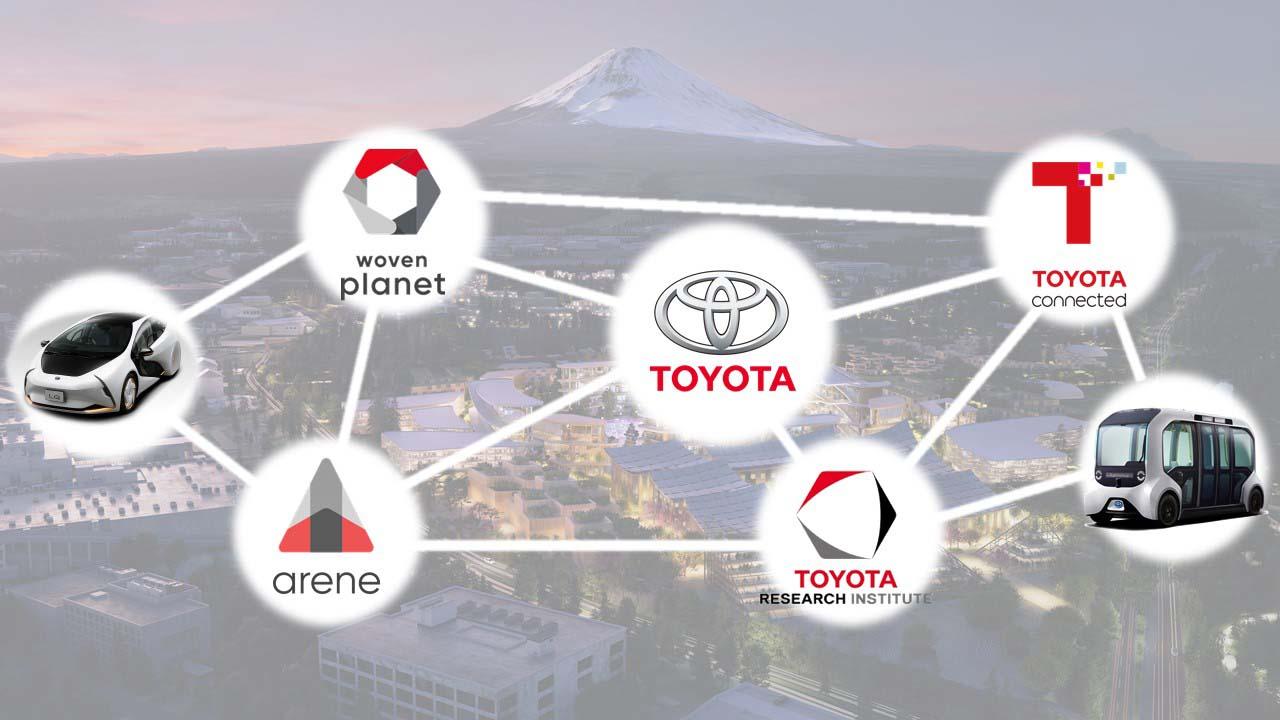
Toyota is also working on a technology which it calls the 'Geofencing Technology'. The company collects data on how much time a Hybrid Electric Vehicle (HEV) is turned off during a full journey. Geofencing refers to the combination of navigation and cloud technologies to enable the automatic switching of engine and motor functions in real time to reflect driving locations and driving times based on geographic data. Geofencing will function as an energy-saver in large. Ahead of introducing geofencing technology, the company has introduced anticipatory eco-driving in October, 2021. The technology realizes highly efficient driving by automatically switching between EV and HEV modes depending on the charge left in the battery and the road conditions and characteristics.
Financial Highlights
FY2023 3Q Highlights
Financial year of Toyota ends on 31 March. The company has reported ¥9,754.6 billion in sales for the period of three months ended 31 December, 2022. Sales during the same period of the past year was ¥7,785.7 billion. Operating income of the company during this quarter is ¥956.6 billion, as compared to ¥784.3 billion the previous period. Other income over these two periods has subsided by ¥230.7 billion. Thereby, including other adjustments, net income attributable to Toyota Motor Corporation during Q3 of FY23 is reported ¥727.9 billion as compared to ¥791.7 billion, a decrease of ¥63.7 billion.
Annual Performance Highlights
Toyota had sales revenues for fiscal 2022 of ¥31,379.5 billion, an increase of ¥4,164.9 billion, or 15.3%, compared with the prior fiscal year. The increase resulted mainly from the ¥1,510.0 billion impact of increased vehicle unit sales and changes in sales mix and the ¥1,390.0 billion favorable impact of changes in exchange rates. Operating costs and expenses increased by ¥3,366.9 billion, or 13.5%, to ¥28,383.8 billion during fiscal 2022 compared with the prior fiscal year. Cost of products sold increased by ¥3,050.8 billion, or 14.4%, to ¥24,250.7 billion during fiscal 2022 compared with the prior fiscal year. Selling, general and administrative expenses increased by ¥341.3 billion, or 13.0%, to ¥2,975.9 billion during fiscal 2022 compared with the prior fiscal year. This increase mainly reflected the unfavorable impact of fluctuations in foreign currency translation rates.
Toyota’s operating income increased by ¥797.9 billion, or 36.3%, to ¥2,995.6 billion during fiscal 2022 compared with the prior fiscal year. This increase was due to the ¥860.0 billion impact of marketing efforts and the ¥610.0 billion favorable impact of changes in exchange rates, partially offset by, among other factors, the ¥360.0 billion aggregate unfavorable impact of factors categorized as cost reduction efforts (including fluctuations in raw materials prices) and the ¥220.0 billion aggregate unfavorable impact of changes in expenses and expense reduction efforts. Net income attributable to Toyota Motor Corporation increased by ¥604.8 billion, or 26.9%, to ¥2,850.1 billion during fiscal 2022 compared with the prior fiscal year. Earnings per share (EPS) of the company for the fiscal year 2022 is ¥205.23, up from ¥160.65.
Net cash provided by operating activities in FY2022 is ¥3,722 billion, up from ¥2,727 billion year-on-year. Net cash used in investing activities for the years are ¥577.49 billion and ¥4,684 billion, respectively. Net cash used in financing activities in 2022 is ¥2,466 billion, while cash provided by financing activities in 2021 was ¥2,739 billion.
Business Overview
Toyota primarily conducts business in the automotive industry. Toyota also conducts business in finance and other industries. Toyota sold 8,230 thousand vehicles in fiscal 2022 on a consolidated basis. Toyota had sales revenues of ¥31,379.5 billion and net income attributable to Toyota Motor Corporation of ¥2,874.6 billion in fiscal 2022.
Toyota’s business segments are automotive operations, financial services operations and all other operations. Toyota’s automotive operations include the design, manufacture, assembly and sale of passenger vehicles, minivans and commercial vehicles such as trucks and related parts and accessories. Toyota’s financial services business consists primarily of providing financing to dealers and their customers for the purchase or lease of Toyota vehicles. Toyota’s financial services business also provides mainly retail instalment credit and leasing through the purchase of instalment and lease contracts originated by Toyota dealers.
The company has formalized "The Toyota Way" in 2001, two pillars of this way are respect for people and continuous innovation. The philosophy of Toyota, its lean manufacturing system are popularized by wide academic research and books written on them.1
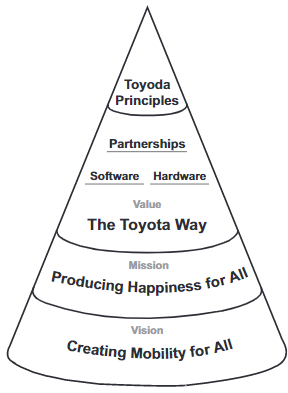
Toyota implements Toyota Production System (TPS) which is based on two concepts Jidoka, and Just in Time (JIT). The first concept is loosely translated as “automation with a human touch,” — an idea of stopping equipment immediately when a problem occurs, in order to prevent defective products from being produced; the second concept based on the idea that “each process produces only what is needed for the next process in a continuous flow.”
Toyota’s vehicles (produced by Toyota, Daihatsu and Hino) can be classified largely into electrified vehicles and conventional engine vehicles. Toyota’s product line-up includes subcompact and compact cars, mini-vehicles, mid-size, luxury, sports and specialty cars, recreational and sport-utility vehicles, pickup trucks, minivans, trucks and buses. Toyota’s luxury cars are sold in North America, Europe, Japan and other regions, primarily under the Lexus brand name.
In fiscal year 2020, Toyota introduced a new Yaris model developed with the aim of creating a car with high-quality ride comfort and the latest safety and security technologies, while taking advantage of the nimble handling of a compact car.
In fiscal year 2022, Toyota launched the first-ever SUV Corolla model, Corolla Cross. Since the launch of the first-generation in 1966, the Corolla series has continued to evolve and embrace new challenges and has sold more than 50 million units worldwide. The Noah and Voxy were redesigned as minivans with the further increased ease of use and enhanced advanced fixtures.
Markets
Japan
Toyota’s consolidated vehicle sales in Japan in fiscal 2022 was 1,924 thousand units, 90.5% of that of the previous fiscal year. Toyota endeavors to secure and maintain its significant share of and position atop, the Japanese market. Toyota held a domestic market share (excluding mini-vehicles) on a retail basis of 48.8% in fiscal 2020, 51.9% in fiscal 2021 and 51.1% in fiscal 2022. The company has 16 production sites in Japan.
North America
In the North American region, Toyota has a wide product lineup in every segment (excluding large trucks and buses). Toyota sold 2,394 thousand vehicles in the region on a consolidated basis in fiscal 2022, representing approximately 29% of Toyota’s total unit sales on a consolidated basis. The United States, in particular, is the largest market in the North American region, accounting for 87% of Toyota’s retail sales in the region. Sales figures for fiscal 2022 were 103.5% of that of the prior fiscal year.
Europe
Toyota sold 1,017 thousand vehicles on a consolidated basis in the region in fiscal 2022, 106.0% of that of the prior fiscal year. Toyota’s principal European markets are Germany, France, the United Kingdom, Italy, Spain and Russia.
Asia
Toyota’s principal Asian markets are Thailand, India, Indonesia and Taiwan. Toyota sold 1,543 thousand vehicles on a consolidated basis in the region in fiscal 2022 (including China), 126.3% of that of the prior fiscal year. Toyota has a production site in Thailand that meets domestic demand and demand of inside and outside of the ASEAN region.
China
Toyota has been conducting operations in China in large part through joint ventures. Toyota has two major joint venture partners in China, namely, China FAW Group Corporation and Guangzhou Automobile Group Co., Ltd. The joint venture with China FAW Group manufactures models such as the Corolla, Vios and RAV4, and the joint venture with Guangzhou Automobile Group Co., Ltd. manufactures models such as the Camry, Yaris and Highlander.
Total vehicle sales in the Chinese market were 25.17 million vehicles in 2021, approximately the same as the 25.21 million vehicles in 2020. In this market, Toyota’s sales in 2021 were 1.94 million vehicles, 107.8% of that of the previous year.
South and Central America, Oceania, Africa and the Middle East
Toyota’s consolidated vehicle sales in South and Central America, Oceania, Africa and the Middle East (collectively, the “Four Regions”) in fiscal 2022 were 1,352 thousand units, 131.7% of that of the prior fiscal year. Toyota’s principal markets in the Four Regions are Brazil and Argentina in South and Central America, Australia in Oceania, South Africa in Africa and Saudi Arabia in the Middle East. The core models in the Four Regions are global models such as the Corolla, IMV (the Hilux) and Camry.
Products
Toyota and its affiliated companies produce automobiles and related components through more than 50 overseas manufacturing organizations in 27 countries and regions aside from Japan. Facilities are located principally in Japan, the United States, Canada, the United Kingdom, France, Turkey, Czech Republic, Russia, Poland, Thailand, China, Taiwan, India, Indonesia, South Africa, Argentina and Brazil.

Toyota Motor Corporation has two lines of business - automotive, and non-automotive. Under the automotive segment, the company produces vehicles, and under the other segment it produces the spare parts and accessories.
Product list 1
| Sedans | Sport | Hatchbacks | Minivans and Cab-wagons | Sport Utility vehicles |
| Century | 86 | Auris | Estima | FJ Cruiser |
| Crown Majesta | Marx X ZiO | Corolla Rumion | Estima hybrid | Land Cruiser Prado |
| Crown | Avensis | Porte | Isis | Land Cruiser |
| Crown Sedan | Succeed | Ractis | Prius a | Harrier |
| Crown Comfort | Corolla Fielder | bB | Wish | Rush |
| Comfort | Probox | Aqua | Sienta | RAV4 |
| SAI | ist | Alphard | Vanguard | |
| Mark X | Vitz | Vellfire | Harrier Hybrid | |
| Prius | Passo | Noah | ||
| Allion | iQ | Voxy | ||
| Premio | ||||
| Camry | ||||
| Belta | ||||
| Corolla Axio | ||||
| Prius PHV |
Product list 2
| Van, Trucks and Buses | Minivehicles | Lexus | Others |
|---|---|---|---|
| Succeed | Pixis Space | LS | Hiace |
| Probox | Pixis Van | GS | Regius Ace |
| Hiace | Pixis Truck | HS | Marine Products |
| Townace | Pixis Epoch | IS | Ponam-45 |
| Dyna (2t/1t) | IS F | Ponam-35 | |
| Toyoace (2t/1t) | LFA | Ponam-28 III | |
| Regius Ace | IS C | Ponam-28 L | |
| Liteace | CT | ||
| Coaster | RX | ||
| Quick Delivery 200 |
Spare parts produced by Toyota include Spark plugs, oil filters, wiper blades, disc pads, V belts, bumpers, fender panels, headlights. The company also produces engine oil, and brake fluid, LLC. Under accessories the company produces navigation systems, rearview monitors, rear-seat displays, floor mats, side visors, aerodynamic parts, security products, air purifiers, aluminum wheels etc.
Financial Services
Toyota’s financial services include loan programs and leasing programs for customers and dealers. In July 2000, Toyota established a wholly-owned subsidiary, Toyota Financial Services Corporation, to oversee the management of Toyota’s finance companies worldwide. Toyota currently operates financial services companies in 42 countries and regions, which support its automotive operations globally. Toyota’s sales revenues from its financial services operations were ¥2,324.0 billion in fiscal 2022, ¥2,162.2 billion in fiscal 2021 and ¥2,193.1 billion in fiscal 2020. While there were negative factors in fiscal 2022, such as tight global semiconductor supply relative to demand, supply constraints on new cars due to the impact of COVID-19, and increased competition with other financial institutions, Toyota’s business saw growth mainly due to the accumulated balance of earning assets resulting from enhanced used-vehicle financing, higher used-vehicle prices in the United States and other regions, lower interest rates worldwide and other measures. Through this business segment the company provides services to both the customers and the dealer. The products under the financial services of the company include Green Bonds, commercial paper, corporate bonds, bank borrowings, ABCP (Asset Backed Commercial Paper) and ABS (Asset Backed Securities). Percentage of credit loss in 2021 and 2022 has been 0.23% and 0.17%, respectively.
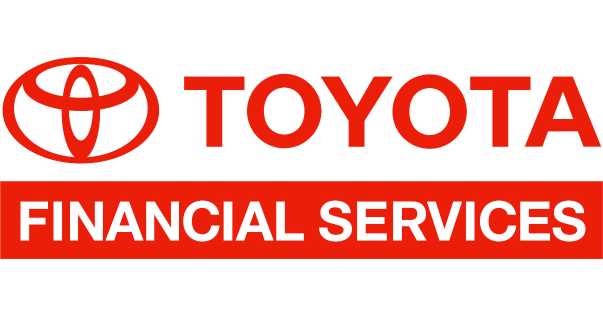
Toyota Motor Credit Corporation is Toyota’s principal financial services subsidiary in the United States. Toyota also provides financial services in 41 other countries and regions through various financial services subsidiaries such as, Toyota Finance Corporation in Japan, Toyota Credit Canada Inc. in Canada, Toyota Finance Australia Ltd. in Australia, Toyota Kreditbank GmbH in Germany, Toyota Financial Services (UK) PLC in the United Kingdom, Toyota Leasing (Thailand) Co., Ltd. in Thailand, Toyota Motor Finance (China) Co., Ltd. in China.
In 2019, Toyota introduced KINTO subscription service which shifts the idea from "owning" cars to "using" cars. The company has developed "TOYOTA Wallet" to provide convenience to the customers for payment purposes.
Finance receivables for all of Toyota’s dealer and customer financing operations were ¥21,764.4 billion as of March 31, 2022, representing an increase of 13.3% as compared to the previous year. The majority of Toyota’s financial services are provided in North America. As of March 31, 2022, 55.0% of Toyota’s finance receivables were derived from financing operations in North America, 13.3% from Europe, 12.9% from Asia, 7.3% from Japan and 11.5% from other areas.
The financing products include retail financing, retail leasing, wholesale financing, insurance, credit cards business etc.
Other Operations
In addition to Toyota's automotive operations and financial services operations, Toyota is involved in a number of other non-automotive business activities. Sales revenues for these activities totaled ¥1,129.8 billion in fiscal 2022, ¥1,052.3 billion in fiscal 2021, and ¥1,504.9 billion in fiscal 2020.
Risks
- Global automotive market is highly competitive and volatile. Factors affecting competition include product quality and features, safety, reliability, fuel economy, the amount of time required for innovation and development, pricing, customer service and financing terms. Volatility of demand can result from changes in economic, social, and political conditions.
- Necessity of continuous innovation in the industry in a timely fashion. If Toyota fails to offer new, innovative and competitively priced products, its revenues may get affected and competitive advantage may subside.
Inability to obtain supplies from a single or limited source supplier may result in difficulty obtaining supplies and may restrict Toyota’s ability to produce vehicles.
Toyota’s operations and vehicles rely on various digital and information technologies, as well as information security.
Toyota is exposed to risks associated with climate change, including the physical risks of climate change and risks from the transition to a lower-carbon economy.
Risks related to currency translation and interest rate fluctuations.
Company History
The history of Toyota Motor Corporation can be traced back to 1933 when Toyoda Kiichiro founded a division in Toyota Industries Corporation (formerly, Toyoda Automatic Loom Works, Ltd.). Toyoda Sakichi, father of Toyoda Kiichiro, founded Toyoda Automatic Loom Works, Ltd. in November 18, 1926, which is now a subsidiary of Toyota Motors Corporation2. Its first production car, the Model AA sedan, was released in 1936. The following year the division was incorporated as the Toyota Motor Company, Ltd., headed by Kiichiro.3 A general timeline of the company shows its development over time through acquisitions, mergers, development of products, and expansion.4
| Year | Particulars |
|---|---|
| 1933 | Toyoda Motor Corporation was found as a division of Toyoda Automatic Loom Works, Ltd. |
| 1936 | First production car Model AA Sedan released. |
| 1937 | Toyota Motors Corporation becomes a separate company in 28 August, 1937. |
| 1941 | Toyoda Machine Works, Ltd. established. |
| 1945 | Toyota Auto Body, Ltd established. |
| 1947 | During the turmoil of WWII, the company paused its production of passenger cars to focus on trucks. In 1947, the company resumes passengers car production with the introduction of Model SA. |
| 1950s | Toyota executives toured to America to observe latest automobile manufacturing technology and they implemented them back home in Japan to see immediate efficiency. |
| 1957 | Toyota Motor Sales, U.S.A., Inc. was established. |
| 1958 | Toyopet Sedan released as the first model to be marketed in the USA. |
| 1958 | The Land Cruiser, a 4 × 4 utility vehicle was released, which saw success in the USA after of poor reception of Toyopet Sedan. |
| 1961 | Total Quality Control (TQC) introduced. |
| 1962 | Publica Sports launched. |
| 1965 | The company redesigned Toyopet to adapt American needs. Toyopet then saw major success in the United States. |
| 1965 | Sports 800 launched. |
| 1966 | Acquired Hino Motors, Ltd., a manufacturer of buses and large trucks. Also, the company acquired Nippondenso Company, a maker of electrical auto components. |
| 1967 | Toyota acquired Daihitsu Motor Company, Ltd. |
| 1968 | Released Corolla in the United States which gained reputation for its low-cost, fuel-efficiency, and reliability. |
| 1982 | Toyota Motor Company was merged with Toyota Motor Sales Company, Ltd. and the present name of the company "Toyota Motor Corporation" was taken. |
| 1984 | Toyota Motor Corporation partnered with General Motors Corporation to initiate a dual-brand manufacturing plant in California namely New United Motor Manufacturing, Inc. |
| 1986 | Toyota began U.S. production through New United Motor Manufacturing, Inc. |
| 1989 | First luxury brand Lexus was in introduced |
| 1997 | The company introduced first mass-produced hybrid-powered vehicle in the world, the Prius. |
| 1999 | Toyota got listed on both the London Stock Exchange and the New York Stock Exchange. |
| 2003 | Scion brand was introduced targeting the younger buyers. |
| 2005 | Unveiled world's first luxury hybrid vehicle, the Lexus RX 400h. |
| 2010 | Toyota made a safety recall of more than eight million vehicles worldwide. This affected the financial condition of the company further after the financial crisis in 2008. |
| 2014 | The United States recalled millions of vehicles including many of Toyota's because of potentially malfunctioning airbags produced by the Japanese automotive-parts supplier Takata. |
| 2016 | Toyota Research Institute (TRI) established |
| 2020 | GR Yaris launched. Toyota Philosophy and Toyota Way established. |
| 2021 | Construction of "Woven City" launched. The idea of Woven City is that all the people, buildings, and vehicles can communicate with each other via real-time data and embedded sensors.5 |
| 2022 | 16th generation Crown launched. |
- ^ https://www.toyota-europe.com/about-us/toyota-vision-and-philosophy/the-toyota-way
- ^ http://www.toyota-global.com/company/history_of_toyota/75years/data/conditions/company/group/profiles.html
- ^ https://global.toyota/en/company/trajectory-of-toyota/history/
- ^ To see more details visit https://www.britannica.com/topic/Toyota-Motor-Corporation
- ^ https://www.forbes.com/sites/bernardmarr/2021/07/26/toyotas-city-of-the-future/?sh=2c666a5a654f




